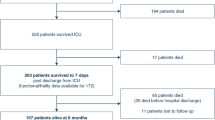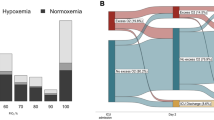Abstract
We analyzed the haemodynamic effects of high doses of r-Met Hu IL-2 [ala-125] in four patients with advanced cancer. Haemodynamic parameters were measured daily from days 1 to 6 of treatment. Mean arterial pressure decreased significantly (98±11 mmHg on day 1 versus 84±7 mmHg on day 5;p=0.0435) as did systemic vascular resistance (2042±296 dynes s cm−5 m−2 on day 1 versus 1166±87 dynes s cm−5 m−2 on day 5;p=0.003). There was a significant increase in mean pulmonary artery pressure (13.25±3.30 mmHg on day 1 versus 20.75±7.41 mmHg on day 5;p=0.03), systemic oxygen consumption (173.5±37.8 ml min−1 m−2 on day 1 versus 257.8±20.5 ml min−1 m−2 on day 5;p=0.02) and cardiac index (3.86±0.58 l min−1 m−2 on day 1 versus 5.77±0.21 l min−1 m−2 on day 5;p=0.008). There was no significant decrease in the arteriovenous oxygen content difference (4.5±0.8 ml dl−1 on day 1 versus 4.46±0.22 ml dl−1 on day 5). Increases in oxygen delivery (570±163 ml min−1 m−2 on day 1 versus 750±109 ml min−1 m−2 on day 5 and oxygen extraction ratio (29.95%±6.37% on day 1 versus 34.60%±4.35% on day 5) were not statistically significant. We concluded that the haemodynamic effect induced by high doses of r Hu-IL-2 is similar to that seen in septic shock.
Similar content being viewed by others
References
Fletcher M, Goldstein AL (1987) Recent advances in the understanding of the biochemistry and clinical pharmacology of interleukin-2. Lymphokine Res 6:45–47
Rosenberg SA, Lotze MT, Mulé JJ (1988) New approaches to the immunotherapy of cancer using interleukin-2. Ann Intern Med 108:853–864
Rosenberg SA, Lotze MT, Muul LM, Leitman S, Chang AE, Ettinghausen SE, Matory YL, Skibber JM, Shiloni E, Vetto JT, Seipp CA, Simpson C, Reichert CM (1985) Observations on the systemic administration of autologous lymphokine activated killer cells and recombinant IL-2 to patients with metastatic cancer. N Engl J Med 313:1485–1492
Rosenberg SA, Lotze MT, Muul LM, Chang AE, Avis FP, Leitman S, Linehan WM, Robertson CN, Lee RZ, Rubin JT, Seipp CA, Simpson CG, White DE (1987) A progress report on the treatment of 157 patients with advanced cancer using lymphokine activated killer cells and IL-2 or high dose IL-2 alone. N Engl J Med 316:889–897
Sarna GP, Figlin RA, Pertcheck M, Altrock B, Kradjian SA (1989) Systemic administration of recombinant methionyl human interleukin-2 [Ala 125] to cancer patients: clinical results. J Biol Response Mod 8:16–24
Sculier JP, Bron D, Verboven N, Klastersky J (1988) Multiple organ failure during interleukin-2 administration and LAK cells infusion. Intensive Care Med 14:666–667
Gaynor ER, Vitek L, Sticklin L, Creekmore SP, Ferraro ME, Thomas JX, Fisher SG, Fisher RI (1988) The hemodynamic effects of treatment with interleukin-2 and lymphokine-activated killer cells. Ann Intern Med 109:953–958
Lee RE, Lotze MT, Skibber JM, Tucker E, Bow RO, Ognibene FP, Carrasquillo JA, Shelhamer JH, Parrillo JE, Rosenberg SA (1989) Cardiorespiratory effects of immunotherapy with interleukin-2. J Clin Oncol 7:7–20
Nora R, Abrams JS, Tait NS, Hiponia DJ, Silverman HJ (1989) Myocardial toxic effects during recombinant interleukin-2 therapy. J Natl Cancer Inst 81:59–63
Isner JM, Dietz WA (1988) Cardiovascular consequences of recombinant DNA technology: interleukin-2. Ann Intern Med 109:933–935
Glauser FL, DeBlois G, Bechard D, Fowler AA, Merchant R, Fairman RP (1988) Review: Cardiopulmonary toxicity of adoptive immunotherapy. Am J Med Sci 296:406–412
Ettinghausen SE, Puri RK, Rosenberg SA (1988) Increased vascular permeability in organs mediated by the systemic administration of lymphokine-activated killer cells and recombinant interleukin-2 in mice. J Natl Cancer Inst 80:177–188
Klausner JM, Morel N, Paterson IS, Kobzik L, Valeri CR, Eberlein TJ, Shepro D, Hechtman HB (1989) The rapid induction by interleukin-2 of pulmonary microvascular permeability. Ann Surg 209:119–128
Sculier JP, Body JJ, Nejai S, Glibert F, Fernandez SG, Thémelin L, Klastersky J (1988) Endogenous production of tumor necrosis factor α in cancer patients during adoptive immunotherapy with IL-2. Proc Am Assoc Cancer Res 29:1604a
Mier JW, Vachino G, Van der Meer JWM, Numerof RP, Adams S, Cannon JG, Bernheim HA, Atkins MB, Parkinson DR, Dinarello CA (1988) Induction of circulating tumor necrosis factor (TNFα) as the mechanism for the febrile response to interleukin-2 (IL-2) in cancer patients. J Clin Immunol 8:426–436
Michie HR, Manogue KR, Spriggs DR, Revhaug A, O'Dwyer S, Dinarello CA, Cerami A, Wolff SM, Wilmore DW (1988) Detection of circulating tumor necrosis factor after endotoxin administration. N Engl J Med 318:1481–1486
Author information
Authors and Affiliations
Rights and permissions
About this article
Cite this article
Diana, D., Sculier, J.P. Haemodynamic effects induced by intravenous administration of high doses of r-Met Hu IL-2 [ala-125] in patients with advanced cancer. Intensive Care Med 16, 167–170 (1990). https://doi.org/10.1007/BF01724796
Received:
Accepted:
Issue Date:
DOI: https://doi.org/10.1007/BF01724796




